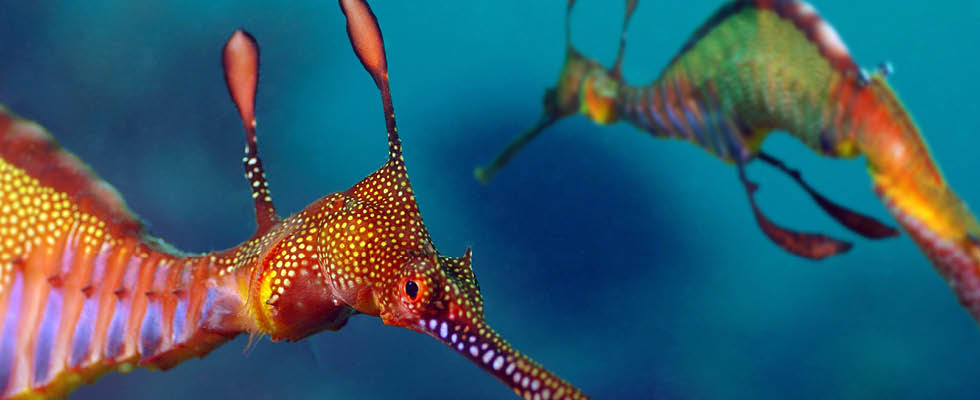
Established in 2012, the Greater Cleveland Aquarium occupies a historic site on the west bank of the Cuyahoga River: the FirstEnergy Powerhouse. This structure, built in 1892, originally provided power for Cleveland’s streetcars and railways. Today, the building remains a center of applied science, as the aquarium cares for the life support needs of close to 3,000 animals.
With a scientific approach and the right measurement technology, the Life Support Systems (LSS) team and others are able to make smart decisions about how to spend their time. Systematic flow measurement with portable ultrasonic flow meters allow the LSS team to optimize filter maintenance for their weedy seadragons without putting them at risk.
Growing Scarce in the Wild
Native to the coastal waters near Australia, the weedy seadragon is showing signs of population decline in the wild, as warming seas and other factors make their home less hospitable.
Australia no longer permits the collection or export of weedy seadragons, making successful propagation even more important for aquariums. Creating the
right conditions for births under human care remains easier said than done. Across the world, only around 20 marine life facilities have had successful weedy seadragon hatchings.
The Greater Cleveland Aquarium has included weedy seadragons among its aquatic residents since 2018, when the facility underwent a major renovation. The aquarium was able to house the seadragons in an exhibit built into a structure that provided them enough vertical depth for an optimal habitat.
A New Responsibility
At birth, seadragon fry only measure .75-inches in length and strongly resemble drifting pieces of vegetation. For several weeks in the late fall of 2021, the aquarium team kept a close eye on the seadragon habitat, checking for new hatchlings hourly and transferring them temporarily to a separate environment for special care.
Even adult seadragons require a highly specific set of conditions to thrive. In addition to vertical space, they need places to hide, as well as protection from noise and vibration. Their most fundamental needs include safe flow conditions and excellent water quality.
The aquarium first housed the fry in a kreisel, a vessel designed to create circular flow that is often used for especially delicate organisms. When it came time for the young to graduate to a holding tank, the team took every precaution.
An Elegant Solution
To keep the seadragons’ environment clean, the aquarium’s LSS team originally changed the tank’s pleated paper filters every day. However, with the more than 300 other species needing care as well, conserving staff time is always important. The LSS team came up with a solution: to measure flow rate over time as an approach to learning how quickly flow rates decrease as the filters collect debris.
Mechanical filtration represents a critical first step in the process of keeping an aquatic environment clean and safe. Water from the tank is circulated through mechanical filters (such as the pleated paper filters used at Greater Cleveland Aquarium) to physically strain out suspended particulate matter from animal waste or decomposed vegetation. Once the largest particles are removed in this way, the water can be passed through biologic or chemical filters that remove nitrogenous compounds, kill microbes and improve water clarity. The water then returns to the holding vessel once any treatment chemicals have abated. If needed, the water can also be chilled or heated to the temperature the animals require.
Since their function is to trap large particles, mechanical filters become clogged over time and must be cleaned or replaced. Their status can be evaluated either by measuring flow or measuring differential pressure across the filter. However, the differential pressure approach requires two measurements rather than one and inevitably means intrusion into the piping system. Using traditional water sensors to measure flow would similarly involve direct intrusion into the piping.
At the Greater Cleveland Aquarium, however, life support staffers were able to use an ultrasonic transit-time flow meter with a portable clamp-on design. Guide rails for the ultrasonic transducers were left in place on the outside of the pipe to
ensure precision, but the transducers themselves could be removed between measurements to prevent corrosion inside the coaxial terminals.
Finding the Sweet Spot
Readings were taken at the same time each day for three weeks, each requiring only about 10 to 15 minutes from setup to removal. During this trial, no more than a 10% decline in flow rate would be tolerated before filters were changed.
Over the course of a single day, staffers measured only minimal declines in flow rate, from 12.1 gallons per minute (gpm) to 12.0 gpm. By day three, flow had only declined by about 3%. However, flow began to diminish more rapidly by days four (7%) and five (10%). With this information, the team was able to set a schedule to change the filters every three days.
Portable technology allows the aquarium to take flow readings from any part of an animal’s habitat. With the success of their seadragons, the team can continue to use the technology to make further enhancements across their exhibits.

